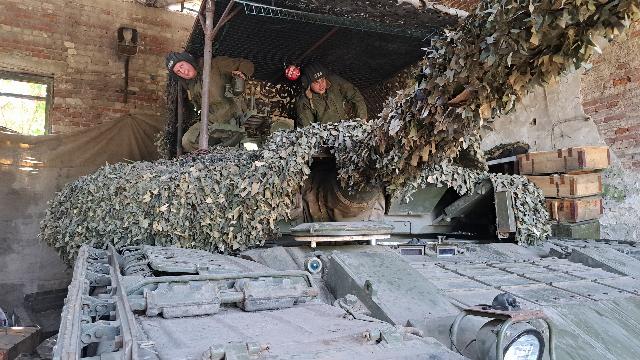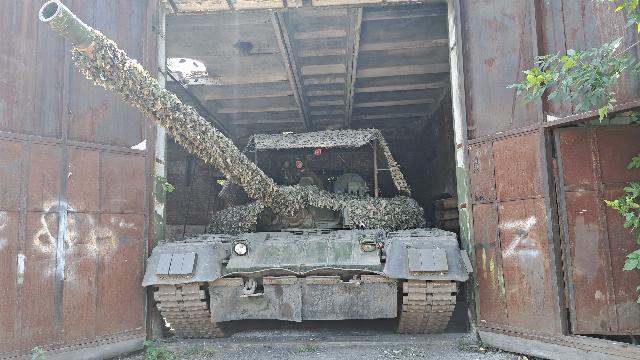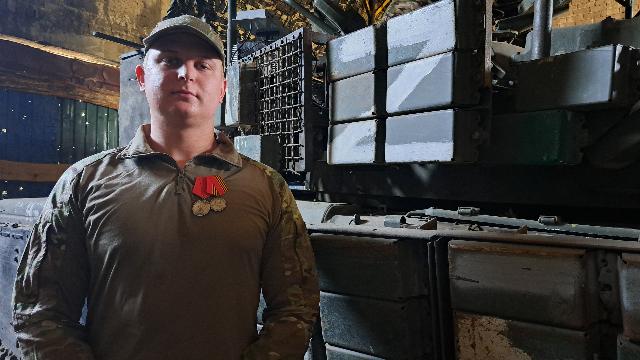Combat experience constantly makes adjustments to the tactics of using armored vehicles
Tanks continue to play a significant role in the advance of our troops, despite the large number of UAVs and the saturation of enemy positions with anti-tank weapons. The vehicles receive additional protection and are quickly repaired by the crews whenever possible. Combat work in today's conditions takes place both from long distances from closed firing positions, and in direct support of assault groups, with direct fire. Izvestia learned how the tankers of the 10th separate Tank Battalion (OTB) operate.
Armored and dangerous
10 OTB of the Armed Forces of the Russian Federation — the former separate tank battalion of the People's Militia of the DPR "Diesel", which began the war on captured equipment. Many techniques that have become widespread throughout our army today, such as firing from closed firing positions when adjusted from a quadcopter, began to be introduced in this part even before the start of a special military operation. Today, the legendary formation is fighting on T-80 gas turbine tanks of various modifications, which it was re-equipped with in 2022. Many crews still consist of residents of Donbass, who began their combat path before the start of their military service.
— I received these two medals, "For Bravery" and "Zhukov", back when I was working at Marinka. For excellent military service. We have been together with the crew for a long time, since the beginning of the Marinka (we are talking about the first entry into the Marinka in the spring of 2022 by the forces of the NM DNR. — Izvestia). We rallied so well, we immediately began to understand each other perfectly.

Image source: Photo: IZVESTIA/Dmitry Astrakhan
Sometimes they didn't even tell each other, but already knew what to do in advance, when and what to do, what task," says the tank commander with the call sign Litvin. He has been serving since 2020, he came as a driver. Litvin himself is from the village of Komsomolskoye, and the gunner and mechanic-driver are from Shakhtersk. They did not have a chance to participate in the battles of 2014-2015 due to their age, but they witnessed them in their hometowns.
The conversation is taking place near the T-80 tank, which is being repaired after damage. The machine of the early versions is equipped with additional dynamic protection, almost all free areas are occupied by the "Contact-1" blocks. The tower is covered from above with a large square canopy, which is popularly known as the "barbecue". And behind the tower, without interfering with its rotation, large rectangular boxes are fixed, which simultaneously protect the engine from damage from above and give a large volume for storing necessary things, tools, camouflage nets, etc.

Image source: Photo: IZVESTIA/Dmitry Astrakhan
In the literature, this solution is called the "Rommel box" — it is believed that the first such design was used by German tankers to store supplies during battles in Africa. But today such a decision is already quite strongly associated with the Donbass style of "tuning" military equipment.
On the additional visor, a powder fire extinguisher is mounted on a suspension from above, which is triggered at a temperature of 200 degrees, respectively, extinguishes the tower from above in case of fire. And along the perimeter, on the ZIP boxes, there are several powerful electronic warfare (EW) systems units. Tankers say that, watching the recordings of video cameras mounted on the tank in combat conditions, they saw the fall of enemy kamikaze drones 5-10 m from the car. Of course, it is almost impossible to see such a small target in battle with the help of surveillance devices. But such videos give confidence that the protection is working.
New tactics
Today, tanks are mostly threatened by artillery and UAVs, but direct tank-against-tank battles have become a vanishing rarity.
— I do not even know directly, there is little chance of meeting the technique. There was a task once — to meet the enemy "sixty-four" (T-64) on Marinka, but she did not arrive. I stood, waited, waited, for 10-15 minutes, but the enemy did not arrive," Litvin tells about the only case in his combat path when he could join a tank battle.

Tank Commander Litvin
Image source: Photo: IZVESTIA/Dmitry Astrakhan
The gunner operator Victor, as well as the commander, has been serving since 2020, immediately after school he went to the NM DNR and to the institute in absentia.
Gunner operator Victor
Image source: Photo: IZVESTIA/Dmitry Astrakhan
The combat path began on the first day of the SVO, when tankers broke through the first line of Ukrainian fortifications in the former Petrovskoye – Bogdanovka area of separation of forces and means, where a stable ceasefire had not been achieved over the years of the Minsk Agreements.
— Bogdanovka was our first battle, which we entered. There was even some kind of military romance there, then everything was still different. Yes, then Nikolaevka, Novognatovka, Starognatovka, then we reached Volnovakha, took Volnovakha. From there, we already went to storm Marinka, our tanks were the first to enter Marinka," Victor recalls the year 2022, when at the beginning of his war, before the mass appearance of kamikaze drones, tanks were used as the main force during breakthroughs.
Such episodes are extremely rare at the current stage of ITS development. During the battles, machine commanders and operators mastered the skills of shooting from closed positions, adjusting fire and much more, which was previously considered necessary rather in self-propelled artillery. But the accuracy and rate of fire of tank guns and the mobility of armored vehicles themselves are still needed today. Where competent commanders know how to apply the strengths of technology, tankers continue to successfully complete tasks.
In June, Izvestia reported how tankers were supporting the advancing troops in the Avdiivka direction with fire. They began to widely use drones in their work. In particular, such a technique as working from closed firing positions (ZOP) requires adjustments from the air. Firing from the ZOP allows tanks to "break the distance" and work from a much greater distance.
Dmitry Astrakhan

